If you’re new here, you may want to subscribe to my RSS feed to receive the latest Architectradure’s articles in your reader or via email. Thanks for visiting!

Attribution: Photo of a snoezelroom at Het Balanske, Halensebaan 2, 3390 Tielt-Winge, Belgium by Michaël RY Laurent, Belgium.
Snoezelen or controlled multisensory stimulation is used for people with (severe) mental disabilities, and involves exposing them to a soothing and stimulating environment, the “snoezelen room”. These rooms are specially designed to deliver stimuli to various senses, using lighting effects, color, sounds, music, scents, etc. The combination of different materials on a wall may be explored using tactile senses, and the floor may be adjusted to stimulate the sense of balance.
Originally developed in the Netherlands in the 1970s, snoezelen rooms have been established in institutions all over the world (like in Germany, where more than 1200 exist).
Snoezelen might be beneficial to people with autism and other developmental disabilities, dementia, and brain injury. However, research on these matters is scarce, with variable study designs.[1] [2]
References
[1]Chung JCC, Lai CKY. Snoezelen for dementia. The Cochrane Database of Systematic Reviews 2002, Issue 4. Art.
[2]Lancioni GE, Cuvo AJ, O’Reilly MF. Snoezelen: an overview of research with people with developmental disabilities and dementia. Disabil Rehabil. 2002; 24: 175-84.
by Wikipedia
Effects of Snoezelen room, Activities of Daily Living skills training, and Vocational skills training on aggression and self-injury by adults with mental retardation and mental illness. Res Dev Disabil. 2004 May-Jun;25(3):285-93. By Singh NN,
Lancioni GE, Winton AS, Molina EJ, Sage M, Brown S, Groeneweg J.
Abstract Multi-sensory stimulation provided in a Snoezelen room is being used increasingly for individuals with mental retardation and mental illness to facilitate relaxation, provide enjoyment, and inhibit behavioral challenges. We observed aggressive and self-injurious behavior in three groups of 15 individuals with severe or profound mental retardation and mental illness before, during, and after being in a Snoezelen room. All participants were receiving psychotropic medication for their mental illness and function-derived behavioral interventions for aggression, self-injury, or both. Using a repeated measures counterbalanced design, each group of participants was rotated through three experimental conditions: Activities of Daily Living (ADL) skills training, Snoezelen, and Vocational skills training. All other treatment and training activities specified in each individual’s person-centered plan were continued during the 10-week observational period. Both aggression and self-injury were lowest when the individuals were in a Snoezelen room, followed by Vocational skills training and ADL skills training. The levels in the Snoezelen room were significantly lower than in both the other conditions for aggression but only in ADL skills training for self-injury. The difference in levels before and after Snoezelen were statistically significant with self-injury but not with aggression. The order of conditions showed no significant effect on either behavior. Snoezelen may provide an effective context for reducing the occurrence of self-injury and aggression.
PMID: 15134793 [PubMed – indexed for MEDLINE]



















